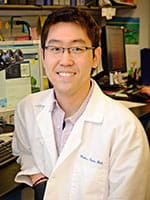Andy Kim
 Hometown: Cupertino, California
Hometown: Cupertino, California
Undergraduate Institution: Duke University
I’ve always believed that developmental biology is a discipline where you can truly unleash your inner “mad scientist”. It is also where you become an artist, orchestrating cellular acrobatics to tell your story to a wider scientific community.
When I took a developmental biology course for the first time as a sophomore at Duke University, the idea of creating mutants (e.g., extra heads, eyes, and limbs) to study development and pediatric disease was simply mind blowing. To me, the intricate cellular movements and complex signaling processes involved in generating a living organism from a single cell was a true reflection of nature at its best.
Having cultivated a healthy obsession with heart development and pediatric cardiology along the way, I wanted to study this beautiful organ from as many different perspectives as possible. As a result, my journey during my undergraduate and post-baccalaureate years led me to work in several heart labs – not just at Duke, but also the National Heart, Lung, and Blood Institute at the NIH, the University of Pittsburgh School of Medicine, and the Children’s Hospital of Pittsburgh.
But throughout my time working at these various locales, one institution always stood out to me: Cincinnati Children’s. Scientists and physicians representing this world-renown pediatric powerhouse were everywhere – from various conferences at which I presented my work, to the news media, seminars by affiliated guest speakers, and even the subject of casual conversation in the lab. Of course, this should not be surprising since Cincinnati Children’s ranks consistently within the top 3 NIH-funded pediatric institutions in the US. Knowing that I would receive excellent medical and graduate training here, I soon decided to join the Medical Scientist Training Program (MD/PhD), jointly supported by Cincinnati Children’s and the UC College of Medicine.
The Molecular and Developmental Biology Graduate Program was an obvious choice for the graduate portion of my training because it provides access to top scientists and physicians in their respective pediatric specialties. You become part of a close-knit community that prides itself in providing its students the best mentorship and opportunities to take ownership in cutting-edge research that is not available elsewhere in the country. This certainly is not limited to developmental biology, and the flexibility of this program enables students to find an area that best interests them. Furthermore, there is definitely a sense of camaraderie among faculty and students, thereby providing numerous opportunities to collaborate with each other and labs across the globe in groundbreaking research. To me, all these factors were critical as they allow me to explore and integrate both my clinical and scientific interests in my training to become a physician scientist.
Publications
Li Y, Klena N, Gabriel G, Liu X, Lemke K, Chen Y, Kim AJ, Chatterjee B, Damerla R, Chang GF, Yagi H, Shan Y, San Agustin JT, Thahir M, Anderton S, Lawhead C, Vescovi, A, Weeks DE, Pratt H, Morgan J, Smith CL, Eppig JT, Reinholdt L, Leatherbury L, Tobita K, Francis R, Ganapathiraju M, Pazour GJ, Lo CW. The genetic landscape for congenital heart disease in mice. (2014) Nature (Revision in review)
Leung W et al. Drosophila Muller F elements maintain a distinct set of genomic properties over 40 million years of evolution. (2014) Genetics (Submitted)
Kim AJ, Francis R, Liu X, Devine W, Ramirez R, Leatherbury L, Tobita K, Lo CW. Assessment of structural birth defects in mutant mouse lines using micro-computed tomography. (In Preparation)
Liu X, Francis R, Kim AJ, Ramirez R, Chen G, Subramanian R, Anderton S, Kim Y, Wong L, Morgan J, Pratt CH, Reinholdt L, Devine W, Leatherbury L, Tobita K, Lo CW. Interrogating congenital heart defects with noninvasive fetal echocardiography in a mouse forward genetic screen. Circ Cardiovasc Imaging, 2013;7(1):31-42. PMCID: 3962690
Kim AJ, Francis R, Liu X, Devine WA, Ramirez R, Anderton S, Wong L, Faruque F, Gabriel GC, Chung W, Leatherbury L, Tobita K, Lo CW. Micro-computed tomography provides high accuracy congenital heart disease diagnosis in neonatal and fetal mice. Circ Cardiovasc Imaging, 2013;6(4):551-559. PMCID: 3908688
Qu W, Tokar EJ, Kim AJ, Bell MW, Waalkes MP. Chronic cadmium exposure in vitro causes acquisition of multiple tumor cell characteristics in human pancreatic epithelial cells. Environmental Health Perspectives, 2012;120: 1265-1271. PMCID: 3440134
Hutson M, Zeng L, Kim AJ, Antoon E, Harward S, Kirby ML. Asymmetrically dividing cardiogenic progenitors interpret opposing FGF/BMP signals to proliferate or differentiate. Development, 2010;137: 3001-3011. PMCID: 2926953



